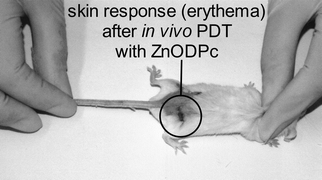Two octa-substituted phthalocyanines, namely 1,4,8,11,15,18,22,25-octakis(decyl)phthalocyaninato zinc(II)
(ZnODPc) and 1,4,8,11,15,18,22,25-octakis(pentyl)phthalocyaninato zinc(II)
(ZnOPPc), were investigated for their use in photodynamic therapy (PDT) after topical application. Both substances exhibited favourable properties as photosensitisers in vitro: absorption maxima around 700 nm with absorption coefficients of about 190000 (M−1 cm−1), a singlet oxygen quantum yield of 0.47 ± 0.02 (ZnODPc), and good accumulation in keratinocytes and fibroblasts. Cell death after phthalocyanine-photosensitisation appeared to occur mainly via apoptosis. The in vivo experiments demonstrated a good accumulation of the phthalocyanines after topical application in a tetrahydrofuran–azone formulation onto the dorsal skin of Balb/c mice: [(4.6–4.7)
± 1.0]% of deposited dye could be recovered after 3 h from deposition. ZnODPc showed significantly better skin-photosensitising properties than ZnOPPc and is therefore a potential candidate for the treatment of psoriasis.


 Please wait while we load your content...
Please wait while we load your content...